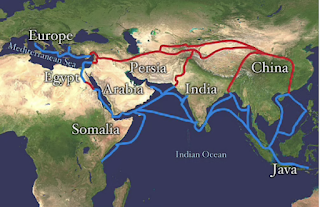The power of art
 |
| Sultan Mehmed the second by Gentile Bellini |
The Power of Art
Ever since art emerged, it has always been about showcasing skills and knowledge.
In the 14th century, The emergence of the Renaissance movement made a pivotal role in changing concepts and ideas of humanism, began among writers and intellectuals and gradually influenced the art.
Artists started to focus more on the human form and realism, aiming to portray emotional realities and physical spaces through perfected the perspective and the ideal proportion.
What was important the spread about this movement, that it's been created by the elite in the venetian society in Italy first and then to the rest of Europe, globalizing the movement, the world impressed by it's perfectionism and a huge rivalry movement between artists appeared in the horizon to show their skills.
The biographer and artist Giorgio Vasari wrote extensively in the mid-16th century about the lives of artists, including the painter Gentile Bellini, a renowned traveler.
Gentile Bellini was a celebrated painter in Venice, known for his ability to replicate and mimic the real world, including the use of perspective.
There is a reason for why I chose to mention Gentile Bellini in this respect, and here I have to explain something; the revolutionary Renaissance movement came simultaneously with the resurrection of the Ottoman Empire in the east by it's magnificent leader Mehmed the second, the Sultan of Ottoman Empire.
He was named the man who conquered the world, a scholar, a patron of art and a powerful political dynast, he was 21 years old, when he conquered Constantinople in 1453, ending the Byzantine Empire and named the city Istanbul as his Capital. This made him a figure of fear in the West, particularly in the Venetian Republic, which had to accept a peace treaty to maintain its lucrative Mediterranean trade in silk, spices, cotton, metalwork, and more.
The goal of Ottoman Empire is recreate the Roman Empire in the east, Muslim Roman Empire stretched in a wider scope than the Roman Empire, therefore they called themselves the Sultans of Rome.
As part of the successful peace treaty, Sultan Mehmed the second decided that he would like an Italian painter to stay in his court and paint him and his pageantry lifestyle. Gentile Bellini was chosen by the Venetian Senate. He went to Istanbul and accompanied the Sultan for around 15 months, one of the surviving paintings until now is the Sultan Mehmed the Second located in the National Gallery in London.
Here, Let's talk about the power of the art:
The painting has been recognized by art historian as a significant piece in the canon of Italian Renaissance art, representing the global movement in the east.
This painting freezes a moment in the world history to speak out about the relationship between the artist and the patron and the production of art in the context of economic and diplomatic relationships between the east and the west.
This painting registered a powerful statement about the bravery legacy, the heir of Roman Caesars and the champion of Islamic war, who created a significant global Empire and shift the value of the history of Muslim empires through the centuries.
However, if we flip the coin, will know exactly, that the Renaissance movement was a transformative era, shifting the meaning of art and giving it a greater flexibility and accessibility to globalize the subject matters and extending the creativity to reach out a wider circle of artists and sculptors and other crafts people, as well as industries and trades, all in which contributed to the art making process.
Trading wasn't only limited for things, it's for trading people and we all know what would happened when we trade peoples, we trade skills, we trade crafts and more important we trade minds that when they encounter a new culture or a new environment, they give their best and most likely they are ready to accept adaptation and. Integration into the new society.
Apparently, Gentile Bellini wasn't an ordinary painter, he was genius, with extreme caution and attentiveness to his role in the court of the Ottoman Empire, giving him a unique cosmopolitan recognition util today.
This article is inspired by a talk by Elizabeth Rodini, author of "Gentile Bellini's Portrait of Sultan Mehmed II: Lives and Afterlives of an Iconic Image."
For further reading, see "The Lives of the Most Excellent Painters, Sculptors, and Architects" by Giorgio Vasari.



Comments
Post a Comment